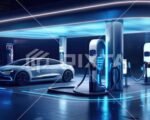The U.S. may be leading in artificial intelligence right now, but with Trump’s latest legislation pulling the plug on clean energy support, some say the country just blinked in its high-stakes tech race with China.
It should’ve been a celebration of dominance. Nvidia briefly topped $4 trillion in market value this week — the first chipmaker to do so — as investors cheered America’s front-runner position in AI. But behind the scenes, Washington just undercut the very foundation that future tech supremacy will need: cheap, sustainable power.
That contradiction lies at the heart of Donald Trump’s “One Big Beautiful Bill Act,” which slashes green energy funding while rewarding coal and fossil fuel producers. The move, analysts say, effectively trades long-term innovation capacity for short-term energy politics.
And it couldn’t have come at a worse time.
A trillion-dollar chip firm and a fossil-fueled foundation
Nvidia’s surge this week wasn’t just about GPUs. It was a moment of national pride. The AI boom — with its torrents of data, new large language models, and billions in investment — is built on silicon.
But silicon doesn’t run on hype. It runs on power. Massive, constant, and increasingly clean power.
Trump’s sweeping bill, signed on July 4 amid much fanfare, does the opposite of what AI infrastructure needs. It:
-
Cuts federal subsidies for solar, wind, and EV infrastructure
-
Slashes R&D funding from Biden’s Inflation Reduction and CHIPS acts
-
Reintroduces tax credits for coal producers
-
Reduces federal royalty rates on coal extraction
“This bill isn’t about tomorrow. It’s about yesterday,” said one energy lobbyist who requested anonymity for fear of political blowback. “It’s saying America’s future will be built with 19th-century tools.”

Data centers are the new factories — and they’re power hogs
The AI revolution needs more than chips. It needs data centers. Lots of them.
According to the International Energy Agency, global data center energy use could more than double by 2026, hitting 1,000 terawatt-hours — roughly Japan’s total electricity use. In the U.S., the expansion is even faster.
“Every ChatGPT query, every AI-generated video, every autonomous vehicle system — all of it runs through server farms,” said Stephen Bartholomeusz, a senior columnist tracking the intersection of tech and power. “And those farms can’t run on fumes.”
AI models, especially large ones like GPT-5 or Gemini Ultra, require intense training over weeks or even months, pulling tens of megawatts per site. Google, Microsoft, Amazon — all are racing to add capacity. But they want clean energy to power it. Not just for ESG reports, but for cost.
Renewables, once built, are cheaper per unit than fossil fuel energy. Killing them now is like refusing to build roads before the invention of cars.
China’s strategy: build AI with clean energy, at scale
China’s not hesitating. State-owned firms are pouring money into solar-heavy data parks in Inner Mongolia and Sichuan, where hydroelectric and photovoltaic capacity is abundant.
“China’s moving in the opposite direction — pairing green energy with AI infrastructure,” said Zhang Wen, an energy analyst at Tsinghua University. “They’re thinking 20 years ahead. America’s thinking 20 months.”
In 2024 alone, China added 217 GW of solar capacity. That’s nearly double the entire electricity demand of California.
Even more critically, China’s AI investments — from Baidu’s Ernie Bot to Huawei’s Ascend chips — are increasingly linked to national strategies for energy, data, and manufacturing autonomy.
Tech investors cheer… but the energy sector’s watching closely
Markets didn’t blink. Nvidia kept flying. The Nasdaq hit another record. But beneath the indexes, there’s tension.
“It’s bizarre to see America crushing it in AI but sabotaging its energy strategy in the same breath,” said Neha Shah, a clean energy fund manager in Boston. “How are you going to scale datacenters if your grid is unstable and expensive?”
Even some fossil fuel companies are confused. One executive at a Houston-based natural gas giant privately admitted: “We’re profiting from this, but long term? This is risky as hell.”
Here’s a quick look at how Trump’s policy shift compares to prior energy spending:
| Policy | Clean Energy Subsidies | Fossil Fuel Support | AI Infrastructure Spending |
|---|---|---|---|
| Biden’s Inflation Reduction Act | $369B | $44B | $52B (via CHIPS & Science) |
| Trump’s OB3 Act | <$10B | $102B | $0 (AI not mentioned directly) |
The mismatch is glaring.
Is this really about China?
Trump’s team argues this is strategic — a reassertion of energy independence, and a rebuke of what they call “China-first policies.”
But critics say that’s a deflection.
“The U.S. is ceding the energy tech race,” said Dr. Carla Romero, a policy analyst at MIT. “Green energy isn’t about hippies anymore. It’s about who powers AI, who powers chips, who wins the 21st-century economy.”
There’s also the issue of global influence. As India, Brazil, and Indonesia gear up their AI sectors, many are looking for clean power partners. Trump’s coal-favoring agenda could isolate the U.S. from tech-aligned emerging markets.
One sentence sums it up: The U.S. just told the world it doesn’t want to lead the future — it wants to argue with the past.








